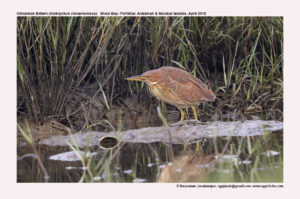
Cinnamon Bittern Ixobrychus cinnamomeus
Etymology :
- Ixobrychus : Greek word ixias reed-like plant; brukhomai – bellow. { found bellow reeds}
- Cinnamomeus: Latin word for Cinnamon coloured
Vernacular Names: Hindi: Laal-bagla, Pun: Lakha bagla, Ass: Itaguria, Ben: Khyri bak, Laal bak, Guj: Surangi pan bagli/bagati, Mar: Laal bagla, Badami Tapas, Ta: Kuruttu kokku, Te: Chinta wakha, Mal: Sandhya kokku, Sinh: Meti kokka
Distribution in India: Resident of Andaman Islands in India.
Description: Size of 40–41 cm; Wt. of 89·5–164 g; wingspan of 49·5 cm. It is smaller with cinnamon and wings and back, with less heavy bill, olive-yellow legs and lacks black crown. Its overall appearance is uniform rich cinnamon on overhead, nape, back, wings and tail. It lacks any contrast between upperwing-coverts and rest of upperparts; chin and throat are buff-white with broad dark brown median streak on foreneck and tuft of loose black and dark brown feathers at base of neck. Rest of the underparts is cinnamon-buff and under wings is pinkish cinnamon to chestnut-grey. In breeding plumage it has yellow, orange or pinkish-red irides, orange bill, purplish-red lores and yellow legs, all of which are brightest in male. The female can be spotted, especially on wings, and has sooty crown, grey wash to back, smaller neck plume cluster and rufous-buff under wings. The non-breeding adult has greenish orange bill, lores are yellow and legs are yellowish green. The juvenile is like adult female, but duller, being drab chestnut-brown with sandy-brown streaking and large spots of same colour on wing-coverts, white throat is streaked dark brown, bright chestnut-brown flight feathers and tail, and chestnut-grey under wings. Compared to young male, juvenile female is much darker overall, being heavily streaked blackish over neck and breast, and spotted buff above.
Habitat: It is found in flooded rice fields and grassy areas, often near human habitation; frequently active in paddy fields with people working nearby; also open freshwater swamps and reed marshes, as well as overgrown ditches in plantations, damp, scrubby thickets and patches of reeds along roads or margins of lakes and pools. It is found from lowlands up to 4000 m.
Food habits: It eats Fish, including eels, frogs, molluscs, insects, prawns and reptiles. It also feeds vegetable matter to chicks. It appears to be active mainly around dawn and dusk, but also frequently feeds by day. It feeds alone and defends feeding territory. Most foraging is done while Walking Slowly, but also uses techniques such as Standing Flycatching, Head Tilting, Peering Over and Head Swaying.
Breeding habits: They breed in Jun–Sept in India, starting with monsoons; in Sumatra in Jan–Mar in lowlands, Oct–Dec in highlands; in Malay Peninsula in Sept, Dec, Feb–Jul; in Java in Oct–Jun; on Borneo in Jun, Aug and Dec and in Philippines in Jul–Aug. They breed in small groups, sometimes in loose association with other herons. They nest on flattened clump of reeds, in cane break or in emergent trees or bushes, usually above water or mud, but sometimes even on ground at base of grass tussocks. The nest is relatively small platform of small sticks, reeds and sedges, lined with a few dead leaves and fine grass. They lay a clutch of 3–5 eggs laid at one-day intervals. The incubation period is 23 days. Incubation is done by both sexes and commencing with first egg.